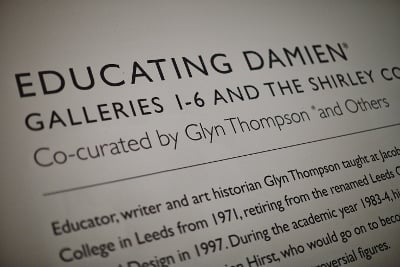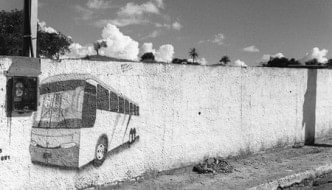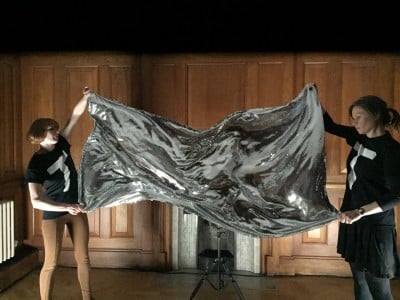The Tetley
May 20, 2014
The Tetley is a contemporary art gallery in central Leeds, resident in the former Headquarters of Tetley’s brewery. After 189 years of production, the brewery site was shut down in June 2011 before undergoing a £1.5m transformation into a ‘visual arts hub’ to support the work of local artists.
This new independent gallery provides opportunity for emerging artists who wish to develop their experience of exhibiting at a larger gallery but would be unable to do so at institutions, such as Leeds Art Gallery or the Henry Moore Institute, which display work of more established names.
Kerry Harker, the director and co-founder of the Tetley told me about the idea behind the creation of the gallery, ‘centres for contemporary art have sprung up all over the UK since the arrival of Tate Modern in 2000, including of course The Hepworth Wakefield which has been a massive success and really bolstered Yorkshire’s cultural tourism economy. But we also felt that Leeds needed a place like this to act as a hub for visual arts activity in the city’.
The building is a stunning example of art deco architecture and I am thrilled that it has been preserved by being transformed into an institution for art and has been opened up to the public. The industrial architecture is being used for cultural services to the community whilst respecting its past. The exterior of the Tetley is majestic; with flags flying overhead, gilded lettering on the Tetley’s signage, an arched gateway and beautiful wooden revolving doors. Stepping into the Tetley, you are confronted by the nostalgic wrought iron lift dead ahead and the buzzing Bar and Kitchen in the background. Harker explains how ‘the potential to take on an entire building was immediately attractive’ and that the site had a ‘massive impact’ on how their ideas developed. She says: ‘We were also excited about the potential to be at the forefront of regenerating the ‘South Bank’ of the city centre, which is now really picking up speed and getting everyone talking.’
The gallery is inviting and spacious. All the levels are connected by a central core or atrium; the hum from other visitors around the building and the Café far below can be heard from the balconies. Natural light streams through the dappled glass of the art deco skylights way above; the space is well-lit throughout due to the abundance of windows and skilfully-placed spotlighting. The original toffee-coloured panelling and parquet flooring gives warmth to the gallery. The Tetley seems homely compared to the poured concrete floors and stark white walls of other contemporary art spaces, which can feel austere. The fittings of the Tetley give the gallery a solidity and permanence, whilst also creating areas of interesting contrast between the modern creative output on display and the historical interior backdrop. It is a nice touch that the Tetley boardroom, which is available for hire, is open to the public. Its leather seats can be seen surrounding the expansive, highly polished table and the paintings of former chairmen from Tetley’s help to give a real sense of the heritage of the building. Harker acknowledges that ‘it wasn’t immediately obvious how it would work as a space for contemporary art. Our ideas about that were challenged and brought into focus when Chetwoods Architects came on board in 2012’. She says ‘the main intervention was to reopen the central atrium, not something that was undertaken lightly, but restoring the original architectural vision from 1931 was the right thing to do.’
The Tetley takes a multimedia approach to what it displays, incorporating a range of art forms including 3D pieces, projections and films into its programme. Artworks that stood out to me were by Samara Scott in the show ‘Skittish’. Dreamcatcher is a 2013 piece using a white venetian blind and mixed media, some of which relate to female grooming such as a pot of pink eyeshadow, a hair curler, hair scrunchie and a small mirror. Some objects were edible, a brownie and a bagel and others household ephemera such as screwed-up tinfoil and rolls of masking tape. Each item is precariously balanced on the slats of the blind and this makes for an intriguing work dangling in the lobby. Scott also produced Cascading Style Sheets (2013), where watercolour, plaster and coloured sand are worked onto plastic sheeting; as well as Solero Tanga (2012), a work of pigmented screen printed latex and poured latex. Hung in the same room, these pieces create an atmospheric presence with their swags of plastic suspended from the ceiling, and govern how the observer moves through the space.
Exciting upcoming events include the gallery’s plan to undertake a project in partnership with Leeds University connected to the First World War: Leeds Stories of the Great War, gathering oral histories from local people. As well as hosting artist and curator symposiums, the Tetley runs inclusive activities to involve the public in the creation of art. Tool Amnesty with artist Ben Cain, a free drop-in event for all ages on the 31st May, asks for people to bring hand tools to the gallery to contribute to Cain’s artwork. Over the Easter Holiday free events for children were run such as an artist-led letterpress workshop using old-fashioned printing techniques. This is an example of the Tetley running creative initiatives to encourage people into the art space while involving its industrial roots.
Harker states that the Tetley is ‘focused on process and production’ and explains ‘we often have artists in residence in the galleries, with an ‘open studio’ ethos that means visitors can meet and talk to the artists themselves, and learn about their work and professional lives. That’s really compelling for younger visitors who might be considering a career in the creative industries. But we try to ensure that all of this happens in a relaxed, friendly and supportive social setting. The Tetley is about everyone learning together, not us saying: ‘Here we are, with all the right answers’.’
The Gallery has inherited Tetley’s archive of documents, objects and art which they see as an ‘untapped resource’. Some artists working on the programme A New Reality, which examines the change in the use of the building from an industrial site to a contemporary arts space, have in some way incorporated pieces from the archive collection into their own work on display. The collection is being shown in a series of ‘Open Archives’ and the public, particularly those connected to the brewing industry, are encouraged to help identify some of the articles in the assortment which is at the moment uncatalogued.
The Bar and Kitchen offers a menu of locally-sourced produce and boasts particularly pleasant staff. It is a social hub, popular both for business meetings over lunch and an oasis for family outings. The design of this part of the Tetley is crisp and modern, with a nod to the traditional, lent by lovely old bar stools, chesterfield sofas and brewery plaques. Overall the Tetley is a very pleasant place to be. It’s been a successful venture as well, having had, as Harker tells me ‘nearly 45,000 visitors in the first five months, which was our original target for the whole of Year 1!’
Helena Roddis
Filed under: Art & Photography
Tagged with: The Tetley



Comments